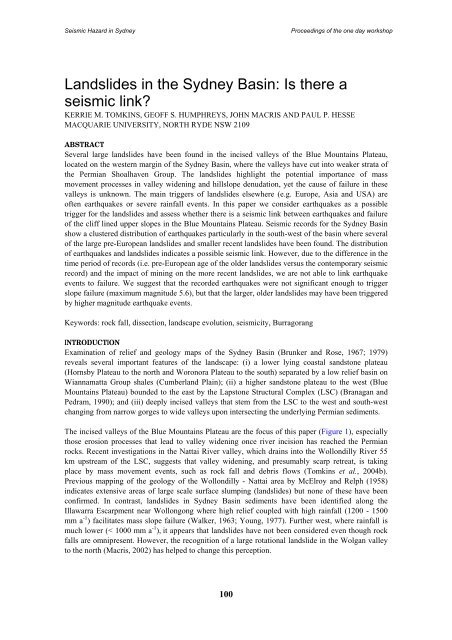Landslides in the Sydney Basin - Geoscience Australia
Landslides in the Sydney Basin - Geoscience Australia
Landslides in the Sydney Basin - Geoscience Australia
- No tags were found...
Create successful ePaper yourself
Turn your PDF publications into a flip-book with our unique Google optimized e-Paper software.
Seismic Hazard <strong>in</strong> <strong>Sydney</strong>Proceed<strong>in</strong>gs of <strong>the</strong> one day workshop<strong>Landslides</strong> <strong>in</strong> <strong>the</strong> <strong>Sydney</strong> Bas<strong>in</strong>: Is <strong>the</strong>re aseismic l<strong>in</strong>k?KERRIE M. TOMKINS, GEOFF S. HUMPHREYS, JOHN MACRIS AND PAUL P. HESSEMACQUARIE UNIVERSITY, NORTH RYDE NSW 2109ABSTRACTSeveral large landslides have been found <strong>in</strong> <strong>the</strong> <strong>in</strong>cised valleys of <strong>the</strong> Blue Mounta<strong>in</strong>s Plateau,located on <strong>the</strong> western marg<strong>in</strong> of <strong>the</strong> <strong>Sydney</strong> Bas<strong>in</strong>, where <strong>the</strong> valleys have cut <strong>in</strong>to weaker strata of<strong>the</strong> Permian Shoalhaven Group. The landslides highlight <strong>the</strong> potential importance of massmovement processes <strong>in</strong> valley widen<strong>in</strong>g and hillslope denudation, yet <strong>the</strong> cause of failure <strong>in</strong> <strong>the</strong>sevalleys is unknown. The ma<strong>in</strong> triggers of landslides elsewhere (e.g. Europe, Asia and USA) areoften earthquakes or severe ra<strong>in</strong>fall events. In this paper we consider earthquakes as a possibletrigger for <strong>the</strong> landslides and assess whe<strong>the</strong>r <strong>the</strong>re is a seismic l<strong>in</strong>k between earthquakes and failureof <strong>the</strong> cliff l<strong>in</strong>ed upper slopes <strong>in</strong> <strong>the</strong> Blue Mounta<strong>in</strong>s Plateau. Seismic records for <strong>the</strong> <strong>Sydney</strong> Bas<strong>in</strong>show a clustered distribution of earthquakes particularly <strong>in</strong> <strong>the</strong> south-west of <strong>the</strong> bas<strong>in</strong> where severalof <strong>the</strong> large pre-European landslides and smaller recent landslides have been found. The distributionof earthquakes and landslides <strong>in</strong>dicates a possible seismic l<strong>in</strong>k. However, due to <strong>the</strong> difference <strong>in</strong> <strong>the</strong>time period of records (i.e. pre-European age of <strong>the</strong> older landslides versus <strong>the</strong> contemporary seismicrecord) and <strong>the</strong> impact of m<strong>in</strong><strong>in</strong>g on <strong>the</strong> more recent landslides, we are not able to l<strong>in</strong>k earthquakeevents to failure. We suggest that <strong>the</strong> recorded earthquakes were not significant enough to triggerslope failure (maximum magnitude 5.6), but that <strong>the</strong> larger, older landslides may have been triggeredby higher magnitude earthquake events.Keywords: rock fall, dissection, landscape evolution, seismicity, BurragorangINTRODUCTIONExam<strong>in</strong>ation of relief and geology maps of <strong>the</strong> <strong>Sydney</strong> Bas<strong>in</strong> (Brunker and Rose, 1967; 1979)reveals several important features of <strong>the</strong> landscape: (i) a lower ly<strong>in</strong>g coastal sandstone plateau(Hornsby Plateau to <strong>the</strong> north and Woronora Plateau to <strong>the</strong> south) separated by a low relief bas<strong>in</strong> onWiannamatta Group shales (Cumberland Pla<strong>in</strong>); (ii) a higher sandstone plateau to <strong>the</strong> west (BlueMounta<strong>in</strong>s Plateau) bounded to <strong>the</strong> east by <strong>the</strong> Lapstone Structural Complex (LSC) (Branagan andPedram, 1990); and (iii) deeply <strong>in</strong>cised valleys that stem from <strong>the</strong> LSC to <strong>the</strong> west and south-westchang<strong>in</strong>g from narrow gorges to wide valleys upon <strong>in</strong>tersect<strong>in</strong>g <strong>the</strong> underly<strong>in</strong>g Permian sediments.The <strong>in</strong>cised valleys of <strong>the</strong> Blue Mounta<strong>in</strong>s Plateau are <strong>the</strong> focus of this paper (Figure 1), especiallythose erosion processes that lead to valley widen<strong>in</strong>g once river <strong>in</strong>cision has reached <strong>the</strong> Permianrocks. Recent <strong>in</strong>vestigations <strong>in</strong> <strong>the</strong> Nattai River valley, which dra<strong>in</strong>s <strong>in</strong>to <strong>the</strong> Wollondilly River 55km upstream of <strong>the</strong> LSC, suggests that valley widen<strong>in</strong>g, and presumably scarp retreat, is tak<strong>in</strong>gplace by mass movement events, such as rock fall and debris flows (Tomk<strong>in</strong>s et al., 2004b).Previous mapp<strong>in</strong>g of <strong>the</strong> geology of <strong>the</strong> Wollondilly - Nattai area by McElroy and Relph (1958)<strong>in</strong>dicates extensive areas of large scale surface slump<strong>in</strong>g (landslides) but none of <strong>the</strong>se have beenconfirmed. In contrast, landslides <strong>in</strong> <strong>Sydney</strong> Bas<strong>in</strong> sediments have been identified along <strong>the</strong>Illawarra Escarpment near Wollongong where high relief coupled with high ra<strong>in</strong>fall (1200 - 1500mm a -1 ) facilitates mass slope failure (Walker, 1963; Young, 1977). Fur<strong>the</strong>r west, where ra<strong>in</strong>fall ismuch lower (< 1000 mm a -1 ), it appears that landslides have not been considered even though rockfalls are omnipresent. However, <strong>the</strong> recognition of a large rotational landslide <strong>in</strong> <strong>the</strong> Wolgan valleyto <strong>the</strong> north (Macris, 2002) has helped to change this perception.100
















